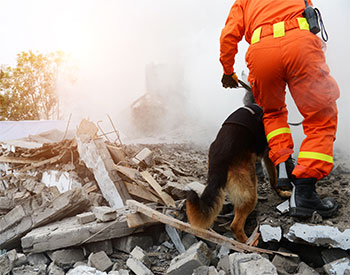
Search and rescue forces search through a destroyed building with the help of rescue dogs.
Animals and Disasters
Your animals need to be included in your family disaster plan since they depend on you for their well-being. Your list of emergency phone numbers should include your veterinarian and your local animal shelter.
Pets
If you must evacuate, DO NOT LEAVE YOUR PETS BEHIND! More thank likely, they will not survive.
Some shelters for both animals and people will not be able to take your pet so take pet records with you in case you must board them, etc.
Ensure your pets have their identification on them (tags, etc.)
Ensure you have a secure pet leash and the disaster supply kit resources for your pet (food, water, medications, records of veterinarian and tags, liter box, dishes first aid kit, information sheet).
Have a backup plan if you are not around when an evacuation occurs such as with a trusted neighbor to take your pets with them. Ensure such neighbors are comfortable with your pets.
Livestock
Evacuate livestock whenever possible.
Prepare in advanee for an emergency transport of livestock and a destination point prearranged, ensuring food, water, veterinary care, etc.
If evacuation is not possible, a decision must be made to move large animals to shelter or turn loose outside (ensure some form of identification on the animal).
Wildlife
Wild or stray domestic animals can pose a danger during many types of disasters.
Do not corner an animal.
If available, contact animal control authorities.
Making a plan with your neighbors saves lives.
Your district may organize for supporting each other during an emergency.
Children experience trauma and fear during a natural disaster. If they know what to do during a disaster because they have practiced family disaster drills, they will be better off. When parents and elders are calm, children calm down more quickly.
Before a disaster, parents and elders can:
●Familiarize yourself with themergency response plans of schools and/or daycare your children attend and the buses they ride and undersand the school/daycare/bus protocol that will occur if there is an emergency.●Establish protocols for children if they arrive home from school when no one else is home and an emergency occurs.
●Develop and practice a family disaster plan
●Teach children how to recognize danger signals.
●Explain how to call for help.
●Explain how to call for help.
●Help children memorize important family information.
●Help children memorize their address if they have one or their physical location.
●Include a child’s favorite toy or special foods in the 72-Hour kit.
After a Disaster:
Children are most afraid the disaster will happen again, someone will be hurt or killed and they will be separated from family and left alone.
Parents and elders can help minimize their children’s fear by:
Keeping the family together and not leaving children with other relatives, neighbors, or friends.
Calmly and firmly explain the situation and your plans.
Talk to your children at eye level.
Encourage children to talk about the disaster and ask questions.
Include children in recovery activities by giving them chores that help them feel they are helping things get back to normal.
Reassure children with firmness and love. Sympathize with and resolve their anxieties. Hold your child and spend more time
